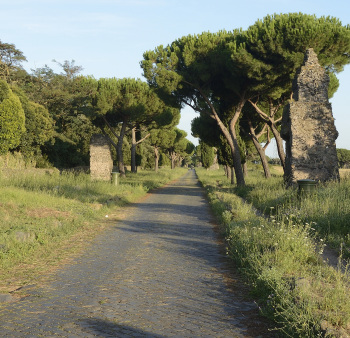The Appian Way
We are now we are about to trace the Apostle Paul's walk along that road, which was at once the oldest and most frequented in Italy, and which was called, in comparison with all others, the "Queen of Roads." It is the Appian Way.
We are no longer following the narrow line of compact pavement across Macedonian plains and mountains walked by Paul, but we are on the most crowded approach to the metropolis of the world. Walking on the Appian Way were praetors and proconsuls, embassies, legions, and many others to their provinces or on return.
The great line of communication between Rome and the southern part of the peninsula was the Appian Way constructed by Appius Claudius It passed through Capua, and thence to Brundusium on the shore of the Adriatic. Puteoli and its neighborhood lay some miles to the westward of this main road, but communicated with it easily by well-traveled cross-roads.

The first part, then, of the route which Julius the solider walked with his prisoner Paul and others in his charge was probably from Puteoli to Capua. The whole line of the road can be traced at intervals, not only in the close neighborhood of Puteoli and Capua, but through intermediate Roman villages and by fragments of pavement, tombs, and ancient milestones.
Capua, after a time of disgrace had expiated its friendship with Hannibal, was raised by Julius Caesar to the rank of a colony. In the reign of Augustus it had resumed all its former splendor and later received accessions of dignity from the Emperor Nero. It was the most important city on the whole line of the Appian Way, between Rome and Brundusium. That part of the line with which we are concerned is the northerly and most ancient portion that Paul likely traversed.
The distance from Capua to Terracina is about seventy Roman miles. At the third mile the road crossed the river Vulturnus at Casilinum. Fifteen miles farther it crossed the river Savo. Thence, after three miles, it came to Sinuessa on the sea, which in Apostle Paul's day was reckoned the first town in Latium.
After leaving Minturnae, the Appian Way passes onto another place, which has different associations with the later years of the Republic. We speak of Formiae, with its long street by the shore of its beautiful bay and with its villas on the seaside. At no great distance from Formiae the road left the sea again, and passed, where the substructions of it still remain, through the stony but productive vineyards of the Caecuban hills.
Arriving in Appii Forum
On the arrival of Paul's party at Appii Forum (Acts 28:15), which was a town where the mules were unfastened, at the other end of the canal, some of the few Christians who were then in the world suddenly recognized one another. Emotions of holy joy ran high and thanksgiving sanctified the place of coarse vice and vulgar traffic.
The disciples at Rome had heard of the Paul's Apostle's arrival at Puteoli, and hastened their walk to meet him on the way. Whoever might be the persons, they were brethren in Christ, and their presence would be an instantaneous source of comfort and strength to Paul. We have already seen, on other occasions of his life, the Apostle's heart was often lightened by the presence of his friends.
Three Taverns
About ten miles farther Paul received a second welcome from a similar group of Christian brethren. Two independent companies had walked to meet him or the zeal and strength of one party had outstripped the other. At a place called the Three Taverns, where a cross-road from the coast at Antium came in from the left, this second party of Christians was waiting to welcome and to honor "the ambassador in bonds."
With a lighter heart and a more cheerful countenance, Paul walked the remaining seventeen miles to Rome, which brought him along the base of the Alban hills, in the midst of places well known and famous in early Roman legends, to the town of Aricia.
The Appian road descended into the plain at Bovillae, six miles from Aricia, and thence it proceeded in a straight line, with the sepulchres of illustrious families on either hand. As Paul and those with him walked over the old Roman pavement, and approached nearer the busy metropolis, the way became more crowded and confusing. The houses grew closer. Before they knew it they were in Rome, as it was impossible to define the commencement of the city.